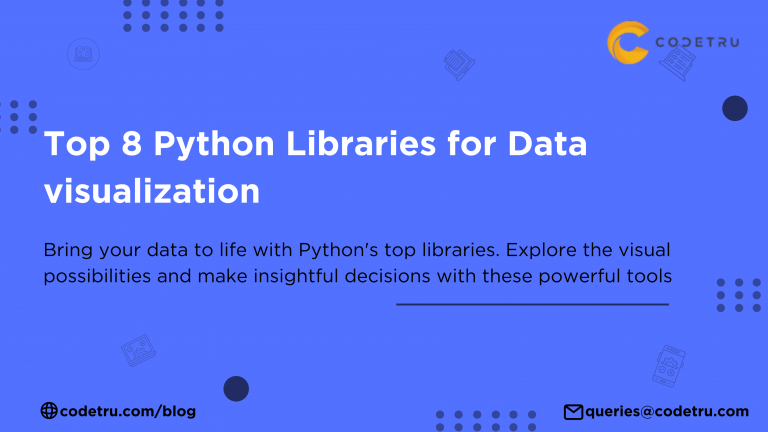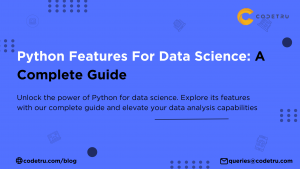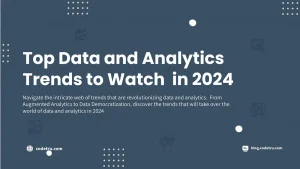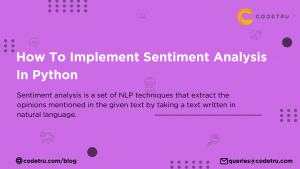A picture is worth a thousand words. Studies have established that the human brain processes information in charts and graphs more easily than in Excel sheets or reports. A key stakeholder of a company or a product might not be interested in the tables or numbers as much as the graphical representation. So, data visualization is of top priority when it comes to data analysis. So, let’s discuss how Python data visualization can be leveraged for data analysis in this blog today
Python is a scientific programming language used extensively for data science, data analysis, and visualization the data. While we can also visualize the data and perform EDA (exploratory data analysis) with Tableau or Power BI, we can create powerful data visualizations using Python as well. There is an ample number of libraries available for creating static and interactive data visualizations such as Seaborn, Matplotlib, etc.
Top 8 Python Data Visualization Libraries
Let’s see these libraries for Python visualization.
Matplotlib
Matplotlib is a great data visualization library to create 2-D interactive graphs. It helps in plotting high-grade, publication-quality graphs that we can zoom, pan, and update. Furthermore, it allows for customization of the visual style and layout of the graphs. It was first introduced in 2003. It is one of the most widely used libraries for creating impressive plots in Python. Also, it can be used to embed graphs into a variety of GUIs such as Tkinter, QT, wxPython, etc. You can plot almost any kind of graph using Matplotlib such as bar graphs, histograms, line graphs, pie charts, scatterplots, box and whisker plots, error graphs, stem plots, power spectra, and many more.
Seaborn
Seaborn is a Python data visualization library built on top of Matplotlib. Seaborn consists of various dataset-related functions that can be applied to data frames for plotting required graphs. We can perform various aggregations or other data manipulations before plotting the graphs for rendering informative output. Seaborn Python is responsible for creating some of the most beautiful and interactive data representations. One can create bar graphs, scatterplots, histograms, line and pie graphs, among others using Seaborn.
Plotly
Plotly is again a free open-source data visualization library built based on the Plotly JavaScript library. It can help in plotting 3-D charts, creating data visualizations not just in Jupyter notebook but also web-based applications using Dash framework and can be saved as individual HTML files. Plotly supports more than 40 unique graph-typed including box plots, multiple axes charts, sparklines, dendrograms, etc. Plotly also helps in creating contour plots that are not a regular graph-form using other Python visualization libraries. The best part about Plotly is, it can be used offline without an internet connection.
ggplot2
GGplot is a Python visualization library that is based on the ggplot2 library of the R programming language. We can create graphical representations using APIs using GGplots. Furthermore, we can create various layers of visualizations using GGplots in a single visualization. The GGplots allow the users to simply map the variables to different aesthetics in the graph and handle the rest of the plotting by itself while the user can focus on reading and interpreting the graphs.
Altair
Altair is again a Python data visualization library for creating beautiful graphs. It is based on the Vega and Vega-lite which are declarative formats for creating, saving, and sharing visualization designs. When the Altair is installed, it comes with some dependencies like Python 3.6, entrypoints, NumPy, Pandas, jsonschema, and Toolz which need to be pre-installed before Altair. However, not to worry, as they all get installed with the Altair package. Altair visualizations can be created by executing the code using any of the above libraries.
Bokeh
Bokeh is a data visualization library developed based on the GGplot. It can be used to create detailed graphics allowing maximum interactivity between the data values. You can create various interactive plots on web applications, HTML pages, or JSON objects. Bokeh offers 3-levels of intensity in creating visualizations. While the first and the second level offers to create basic to medium-level controls on creating graphs, the third level provides complete autonomy in creating high-level graphics and is ideal for data analysts.
Pygal
Pygal is more similar to Plotly or Bokeh libraries in terms of embedding the visualizations as a part of web pages or HTML documents. However, what additionally Pygal offers is the SVGs, the Scalable Vector Graphics. The SVG ensures that the quality of the visualization is not impacted despite zooming in to any scale. However, Pygal is suggested for smaller datasets as bigger datasets can distort the rendering with too many data points.
Geoplotlib
Geoplotlib is one of the excellent libraries for visualizations and one of the most important ones as it helps in creating maps using geographical data. It helps in creating dot-density plots, choropleths, and symbol maps, among others. However, the catch is it needs to have NumPy and Pyglet included before installing Geoplotlib.
Conclusion
Python developers can use any of the above-mentioned popular data visualization libraries based on their need. Plotly, Bokeh, or Pygal can be leveraged when the graphs need to be embedded in the web applications, for map-based visualization Geoplotlib can be used. For 3-D plots, Plotly can be used. Hence, the data analysts can choose the ideal libraries for creating stunning visualizations.
FAQs about Python Data Visualization Libraries
1. What are the best Python libraries for creating high-quality 2-D plots?
Matplotlib is considered to be the best Python library for creating high-quality 2-D plots. It allows greater flexibility and greater usability to create print-quality images.
2. How do I create interactive and beautiful data visualizations in Python?
Seaborn and Plotly are great ways to create interactive and beautiful data visualizations in Python. Seaborn is built on top of Matplotlib and excels at numerical visualization, while Plotly supports interactive plots and can be used in web-based applications.
3. Which Python library should I use to visualize geography?
Geoplotlib is a Python library for continuously visualizing geological data. It is ideal for creating point-density plots, choropleths, and symbol maps, making it perfect for map and geospatial visualization.
4. What is the most suitable Python library for graphics in web applications?
Plotly and Bokeh are well suited for embedding visualizations in web applications. Plotly provides interactive 3-D plots and can be combined with dashed outlines, while Bokeh provides more detailed images with greater interactivity.
5. Which Python library provides scalable vector graphics (SVG) for high-quality zoomable plots?
Pygal is the preferred Python library for creating scalable vector graphics (SVG). This ensures that visualization remains high-quality at any zoom level, making it ideal for high-quality, zoomable plots.







